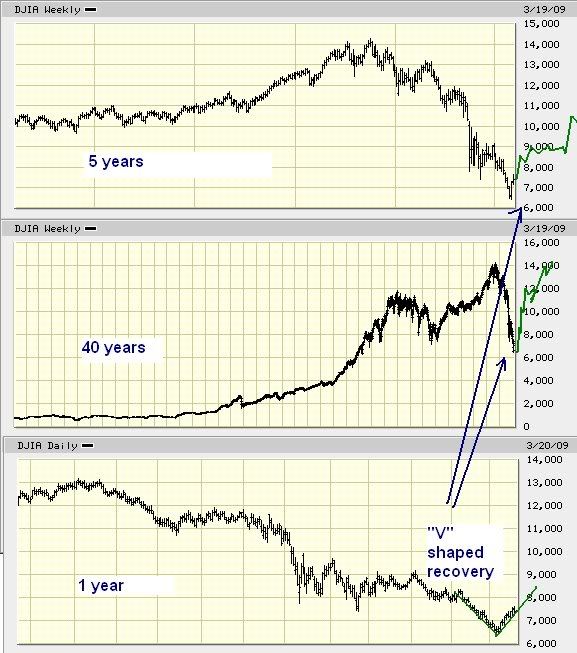Short Sellers & Perma Bears Losing Patience as Market Grinds Higher
On Seeking Alpha and other blogs there is a perpetual output of articles that attempts to call the top of the rally. Just this Monday morning I counted about six of such articles, and probably a couple hundred have been written in the past week alone on Seeking Alpha.
Once article I found amusing is titled Voices Beyond Rally Shows Disconnect. The word ‘disconnect’ should be replaced with ‘desperation’, because that’s how it comes across.
My response is as follows:
But when the dow crosses 10,000 and the S&P 500 crosses 1050 will we still be doubting the ‘realness, and ‘connectivity’ of this rally? How about 12,000? Maybe it’s just a bull market. These sources are propagandizing doom and gloom, but the market already discounted a lot of it, and there is no guarantee any of these scenarios will unfold. As the third wisest human in the world, I would highly advise against shorting this market.
But Paul Krugman’s level of vapidness and pessimism is unmatched. He recently wrote a list of four reasons why the market is going lower titled Green Shoots and Glimmers. Interestingly, the article is written in bullet point format, which seems to allude to some degree of desperation and panic. It’s almost as if Krugman so frantic to debunk the rally that he’s forgotten how to write properly, and is throwing whatever he can find at arm’s length at the wall hoping that something sticks. What he doesn’t realize is that the stock market climbs a wall of worry, and the United States is no longer a manufacturing nation.
In addition, ‘V’ shaped recoveries and employment aren’t mutually inclusive. You can have a ‘V’ shaped recovery in the stock market and the economy with high unemployment, which is known as a jobless recovery. Job losses aren’t so important, anyway as evidenced by the huge rally in stocks in the face of rising unemployment. Increasing efficiency, not payroll, is critical to enabling economic growth and prosperity. Employers as slashing inefficient manufacturing and finance sector jobs, and outsourcing the rest.
The question is how much higher must the market surge before Krugman, Roubini, and other perma bear economists become irrelevant to not only the public, but their peers? These doom and gloomers feed off mayhem and panic. They need to be vindicated. They need to feel relevant. They are irate that the market just refuses to go lower. The Nobel Prize won’t save Krugman from public humiliation when the DJIA eventually does cross 12,000 and fears of ‘recession’ and ‘financial crisis’ and ‘depressionomics’ become merely an afterthought.
Another Week of Gains
Nothing short of divine intervention can stop this bull market.
As a fifth week of gains draws to a close here once again here is a chart showing how the DJIA will retest 14,000 within 2-3 years. It is worth noting that these screenshots were taken on the 19th of March. Since then the DJIA has surged almost 700 points.

The reason why ‘v shaped’ recoveries are possible has to do with this equation which equates volume, price, and slope of a into a scalar value called an energy level. Then you can use another equation to break up the volume into ‘order blocks’ and assign probability of ‘buy orders’ and ’sell orders’ though a normal distribution.

Essentially, what is found that the volume is the most important determinant of the likelihood of symmetrical recoveries. When the volume contracts, ‘v shaped’ recoveries become impossible.
As you can see from the chart, volume is at historic highs:

The new era is here. The Goldilocks economy is real. The transition to a type one civilization is inevitable, along with all the socio and economic changes that come with this phase shift.
I find it amusing how bearish bloggers and commentators are struggling to cope with this rally. As the market grinds higher day after day, so do the losses on the short side. Even the most ardent proponents of leftist, anti-globalist ideology can’t persevere in the wake of assured insolvency. They must all capitulate, and capitulate they will. Each and everyone one of them will be forced to cover as the DJIA marches to 14,000 and beyond, and The Creators of The New World Order tighten their grip on the underpinnings of society. The illusion of a ‘credit crunch’, ‘recession’ and ‘liquidity crisis’ will become a distant memory as greed and excess return with a vengeance. The wealth gap will keep widening, and more spending and debt. More outsourcing and insourcing.

Right Again…Web 2.0 Boom & Debunking Housing Myths
Wow..right again. I told people to buy google earlier this week before earnings and, not surprisingly I’m right again. Google crushes estimates and surges, as well as the entire market. It’s fun making money and being right while these deficit hawks and permabears sit on the sidelines watching everyone else make money in the stock market, while waving their fists at Bernanke, Obama, and Geithener for supposed ‘wasteful spending’..lol what a bunch of sore losers.
There is also a pervasive myth that somehow the last bull market was fueled entirely by American tapping into their homes for equity. In actuality, the growth had more do with strong sales from exports, defense spending, and a steady decline in consumer savings rates. The US consumer is still the cornerstone of the US economy, but this importance is being lessened progressively due to globalization and free trade. Companies like Apple, Walmart, McDonald’s, Google, Potash, and MasterCard are thriving because of globalization, free trade, and a falling dollar.
Here is a great article that debunks the housing myth http://www.financialsense.com/fsu/editorials/jain/2006/0130.html
Most importantly the article states
AT ITS PEAK, THE SINGLE FAMILY HOUSING ALONE WAS ADDING 5.45%, OR 3% MORE THAN THE HISTORICAL TREND-LINE CONTRIBUTION, TO THE GDP GROWTH RATE
The graph below illustrates the insignificance of housing with regards to its contribution to the GDP

But what about the credit crunch and liquidity crisis? As it turns out, the ‘crisis’ was also a hoax. Americans still have access to tons of liquidity and and are still maxing out credit cards, but unfortunately the personal savings rate is at 4%, which is too high. Consumers need to do their duty and spend more instead of being frugal. However, by the end of the year I predict savings rates will return to negative, where it will remain.
We need more credit card debt, easy money, a widening of the wealth gap, outsourcing, bailouts & stimulus, and tax cuts for the rich. It’s the top earners and entrepreneurs who create jobs and economic growth, in addition to paying the bulk of taxes. Economic favoritism is justified because the way you enable growth and prosperity is though the most efficient allocation of economic resources.
Debunking more Doom & Gloom: Job Loss Not Such a Big Deal
Yesterday Seeking Alpha published Andy Abraham’s redundant, farcical article questioning the sustainability of the rally and economic titled; Will Banks Lead the Way to 1929 Crash Part II? Not surprisingly I disagree.
The markets are brushing off the doom and gloom. Intel report brushed off. Retail sales brushed off. Goldman Sachs offering brushed off, as I astutely predicted would happen a few days ago. There will be no repeat of the Great Depression because fed policy is far more proactive. The fed is the enabler of prosperity & innovation though easy, market friendly monetary policy as it has been since the 80’s.
Rising jobless claims and high unemployment isn’t as big of a deal as the doom and gloom media would have you believe. Why?
To be blunt, jobs just don’t matter that much. In the long trend due to automation technology and globalization the mean unemployment rate will continue to rise. But also the definition of the worker is also changing. Instead of regimented, documented payroll work, more people are earning a means though free lance work and and other entrepreneurial endeavors, which may not be tracked by the U.S. Bureau of Labor Statistics.
In addition, One of the main purposes of job cuts is to not only respond to shrinking demand, but to improve efficiency, which subsequently improves the bottom line and leads to technological growth and innovation. There are three types of unemployment recognized by economists. One of them is called structural unemployment, which is when less skilled workers transition to more skilled jobs. if it weren’t for structural unemployment people would still be using vacuum computers or living in hovels. Therefore, rising unemployment and joblessness isn’t necessarily bad for the economy and stock market if efficiency is improved. Creating or subsidizing inefficient jobs as in the case of bailing out General Motors doesn’t help the economy. I write more regarding the insignificance of GM and the changing dynamics of the labor market here iamned.com/blog/?p=198.
Jobless recoveries are now inevitable for all future recessions, including this one like it or not. The bull market lasted for five years despite elevated unemployment in 2003.
People keep talking about a recession but I can’t see it. Please help me find it. Facebook, Twitter, Google, Apple, Slide.com are leading the we 2.0 boom in the silicon valley and are immune to the supposed credit and liquidity crisis. Consumers are still maxing out their credit cards miraculously despite there being no credit, but unfortunately the savings rate is at 4%, but I predict by end of the year it will go negative.
True, things may seem bad now, but the market is looking ahead. In the United States our recoveries are ‘V shaped’ unlike that of Japan, France, or Germany whose economies are bogged down by fiscal conservativeness, consumer frugality, social welfare programs, employer regulation, and higher taxes. The economy is still fundamentally strong.
Also, as a reminder Google is reporting earnings after closing bell today. As I wrote a few days ago, they will smash the estimate and surge in after hours. Just keep buying all the dips and make money. ![]()